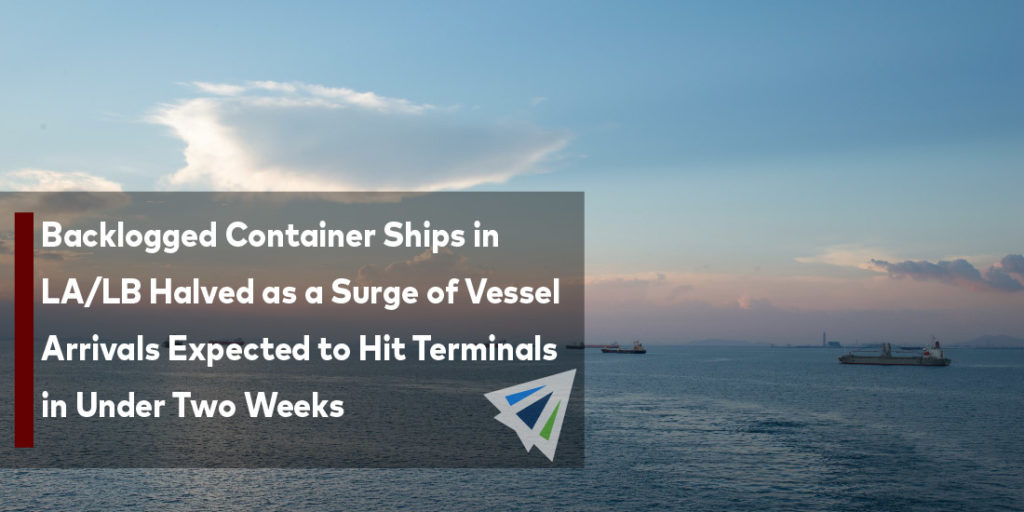Competitive Edge
March 16th, 2022
Stay Current with Interlog’s Weekly Newsletter:
Sign up for our next Coffee & Cargo webinar –> CLICK HERE
To watch last month’s webinar –-> CLICK HERE
Ocean Freight Market Update
Headlines
- Shenzhen has begun a one-week lockdown (March 14 to March 20) due to COVID-19 concerns. Testing actions and work-from-home orders have been applied for the whole city. For more information, see below.
- Freight Waves reports car carrier Felicity Ace, which caught fire last February (all personal on-board were safely evacuated), has sunk in the Atlantic Ocean and, along with it, roughly $500 million worth of luxury vehicles.
UPDATE: Notable U.S./Canada Port Congestion
- Houston: 47 Backlogged Vessels
- Charleston: 35 Backlogged Vessels
- Norfolk/Newport News: 46 Backlogged Vessels
- New York/Newark: 23 Backlogged Vessels
- Los Angeles/Long Beach: 55 Backlogged Vessels
- Vancouver: 73 Backlogged Vessels
- Note: This does not include port-bound vessels waiting at ports of origin
IMPORT: Asia to North America (TPEB)
Recent Developments:
- Shenzhen has begun a one-week lockdown (March 14 to March 20) due to COVID-19 concerns. Testing action and work-from-home orders have been applied for the whole city. Delays in operations are expected with absences in labor, especially with onsite warehouse staff and drivers. Please reach out to our team if you would like additional updates or have any questions/concerns about your shipments.
- Ocean freight trade lanes in Shenzhen will remain normal at export terminals.
- Freight All Kinds (FAK) space remains limited as overall capacity remains severely under
Rates: Rate levels remain elevated. Premium market remains strong.
Space: Space remains critical and is expected to stay tight.
Capacity/Equipment: Capacity remains severely under. Equipment deficits critical.
TIPS: Book at least 4 weeks prior to CRD. Strongly consider premium service and carrier IPIs through the PSW gateway. Be flexible as it comes to equipment and routing.
IMPORT: Europe to North America (TAWB)
Recent Developments:
- USEC port congestion has become more volatile with delays at all major ports and waiting times that range from three to 12 days.
- USWC ports, notably Long Beach/Los Angeles, remain heavily congested with wait times not improving.
- Number of waiting vessels outside USWC ports is expected to increase again.
Rates: Rates levels remain high. Rates will increase as GRIs and PSSs announced for March and April.
Space: Space remains critical, especially for the USWC.
Capacity/Equipment: Capacity remains tight for both North Europe and Mediterranean services. Equipment availability at ports, however shortages remain at inland terminals.
TIPS: Book 5 or more weeks prior to CRD. Strongly consider premium service for higher reliability and no-roll guarantees.
EXPORT: North America to Asia
Recent Developments:
- Ocean freight trade lanes in Shenzhen will remain normal at import docks.
- Diminishing schedule integrity is contributing to void sailings, delays, vessel cut-offs at ports, and challenging post earliest return dates
- Port omissions continue to adversely affect both Charleston and Savannah ports.
- Vessel arrivals remain fluid for USWC POLs
- Rail availability for USWC has become limited with carriers firmly adhering to allocations
Rates: GRI activity (limited) announced for March and April.
Capacity: Available capacity remains fluid for USWC POLs. USEC capacity has become for readily available.
Equipment: IPI origins remain adversely affected by deficits on containers and chassis. Standard equipment availability has not been an issue, but special equipment remains elusive.
TIPS: Book 4 to 6 weeks prior to CRD to secure equipment and vessel space.
AIR FRIEGHT: United States
- Demand, specifically to central Europe, has increased with dwell times of four to six days.
- Rates to Latin America, Europe, and Asia have steadily increased.
- Considerable rises in Aid and Relief efforts have tightened available capacity.
TIPS: Book early considering the current dwell time at airports and reduced available capacity.
Did You Know:
Yang Ming is continuing to waive import box fees, which were supposed to start in the middle of October but due to terminal congestion and high import volumes at many U.S. ports, drayage carriers have been struggling with long truck queues at marine terminals.
These fees were regarding import containers at the ports in California, New York & New Jersey, and the Pacific Northwest. However, the real issue continues to be the empty containers.
If you are wondering the implications this could have for you, please reach out to our team today!
Freight News
Struggles of congestion at the Port of Vancouver continues
The Port of Vancouver continues to deal with a great amount of congestion for the last few months and that is set to continue to increase this week. Laden import containers, which are containers that need to be moved with the right balance of efficiency and precision during the container handling process, are expected to jump to almost 25 percent from the week prior – up to 48,281 twenty foot equivalent units (TEUS), according to the Journal of Commerce (JOC). In addition, data from the Vancouver Fraser Port Authority shows 15 container ships were still at anchor on Friday awaiting for berthing space – this is up from the average of 6-7 vessels per day last month, the JOC reported.
Last month during the Lunar New Year, the Port of Vancouver saw a drop in import volumes – this was a good time for the Port to try and clear some of the cargo backlogs occurring at the Port, but they only saw a slight improvement in clearing backlogs. Back in mid-November the Port was hit with torrential rains and flooding, and in January was hit with below freezing temperatures and snowstorms in British Columbia – both weather events causing significant damage to the rail and highway infrastructure, as the port still continues to try and fully recover from those events. According to the JOC, the average rail container dwell time rose from 3 days in November, to 8.1 days in December, and the average dwells were 7.5 days in January and 5.9 days in February.
Springtime is approaching and officials at the Port are hopeful that the worst of their weather-related issues are over with and in the past.
Lockdown in Shenzhen: What is happening and how it relates to you
As of March 14th, a lockdown has been instituted in Shenzhen, China and is expected to remain in effect until March 20th. In addition, Nucleic Acid Testing (NAT) action has been applied for the whole city and majority of people are now working from home.
This has a direct impact on operations, especially on truck drivers and warehouse staff in the areas. Please see below for the following impacts and updates as of March 14th, according to Dimerco:
- Air freight: Export terminal – terminal operations are expected to be delayed about 1-3 days. Import terminal – due to lack of manpower and the distribution and manifest time limit of imported goods at Shenzhen airport, its around 1-3 days.
- Ocean freight: Export terminal and import dock: all trade lanes are normal
- Trucking at airport: Drivers must have a 24 hour nucleic acid test certificate to enter the operation area of Shenzhen airport (SZX).
- Trucking at ocean terminal: the terminal will receive the container as normal BUT all trucking stop on March 14th (except basic living security, medical and other emergency cases).
- Air carriers: as of now all routes are normal and not affected so much right now.
- Ocean carriers: normal but that schedule could be impacted by the trucking issue
- Air freight/CBRF customs: customs declaration and operation of export/imports will be delayed 1-3 days
- Ocean freight customs: on line operation is normal but if cargo needs to be inspected, that will be a delay of 1-2 days because of the lack of manpower
If you would like additional updates on this situation or have any questions/concerns, please reach out to our team today!
Blog Of The Week

Backlogged Container Ships in LA/LB Halved as a Surge of Vessel Arrivals Expected to Hit Terminals in Under Two Weeks
Sign Up For This Month's Webinar Now:

Join us next Wednesday at 10AM as we discuss the hot topics in the industry, current events, and a live Q&A with our experts!
Sign up for our
industry answers
Our team works to provide valuable, unique, and relevant content to assist you in finding solutions. Sign up now.